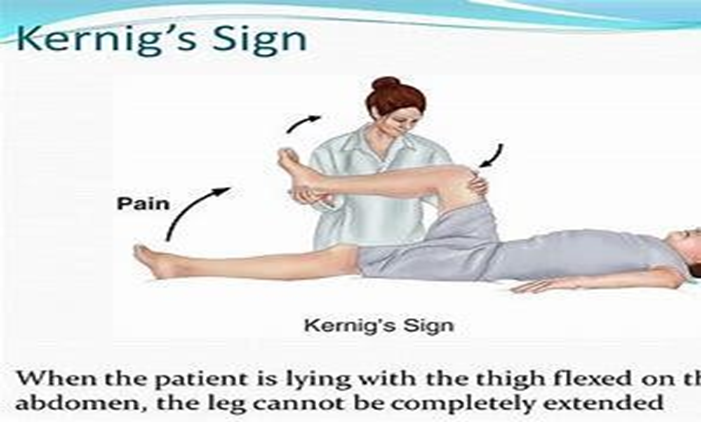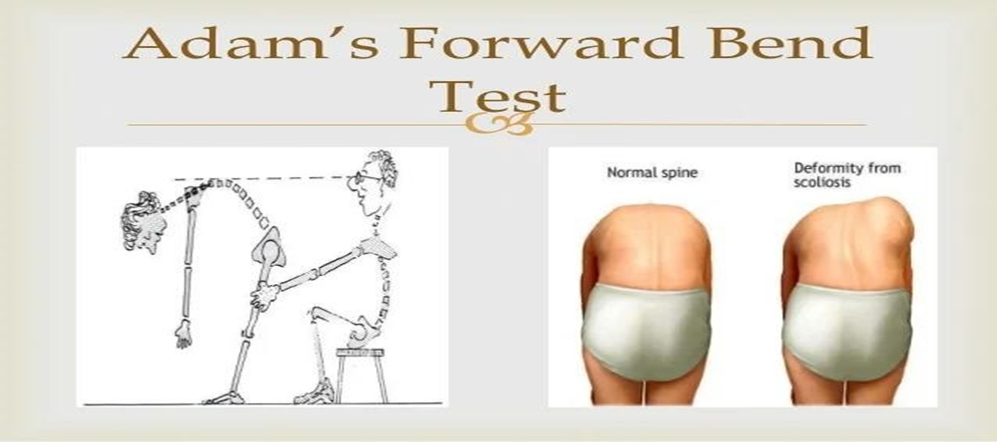The nurse notes documentation that a child with meningitis is exhibiting a positive Kernig's sign. Which observation is a characteristic of this sign?
Petechial and purpuric rashes are noted on the child's trunk
Neck flexion causes adduction and flexion movements of the lower extremities
The child is not able to extend the leg when the thigh is flexed anteriorly at the hip
The child complains of muscle and joint pain
The Correct Answer is C
C. This is characteristic of Kernig's sign. Kernig's sign is elicited when the thigh is flexed at the hip and then attempts to extend the leg at the knee are met with resistance or pain due to inflammation of the meninges.

A. Petechial and purpuric rashes are associated with meningococcal meningitis, not specifically with Kernig's sign. These rashes result from bleeding into the skin and are a characteristic feature of meningococcal sepsis. However, they are not directly related to Kernig's sign.
B. This observation describes Brudzinski's sign, not Kernig's sign. Brudzinski's sign occurs when passive flexion of the neck causes involuntary flexion of the hips and knees due to meningeal irritation.
D. Muscle and joint pain can be symptoms of meningitis, but they are not specific to Kernig's sign. Kernig's sign specifically refers to resistance or pain experienced when attempting to extend the leg at the knee.
Nursing Test Bank
Naxlex Comprehensive Predictor Exams
Related Questions
Correct Answer is C
Explanation
C. Muscle weakness and lack of coordination contribute to difficulties with balance and coordination, leading to frequent falls and clumsiness in children with DMD.
A. DMD typically presents with symptoms such as difficulty climbing stairs, a waddling gait, and calf muscle hypertrophy, rather than atrophy.
B. Delayed fine-motor development is not a typical manifestation of Duchenne muscular dystrophy. DMD primarily affects muscle strength and function rather than fine motor skills.
D. Ambulating by holding onto furniture is not typical in Duchenne muscular dystrophy. As the disease progresses, children with DMD typically experience difficulty walking and may eventually require the use of assistive devices such as wheelchairs or orthoses for mobility.
Correct Answer is D
Explanation
D The forward bending test, also known as the Adam's forward bend test, is commonly used to screen for idiopathic scoliosis. During this test, the child is instructed to bend forward from the waist with their arms hanging downward and palms touching or overlapping. This position allows the nurse to observe the child's back for asymmetry, rib humps, or other signs of spinal curvature characteristic of scoliosis.

A This position may be used for certain examinations, such as assessing the spine's curvature but it is not typically the position used for screening for idiopathic scoliosis.
B This instruction involves cervical spine movement and is not relevant to screening for idiopathic scoliosis. It may be part of a different examination, such as assessing cervical spine range of motion or neurological function, but it does not aid in detecting scoliosis.
C Turning to the side and remaining relaxed may not provide adequate visualization of the spine's curvature, which is essential for scoliosis screening. Additionally, this position does not allow for proper assessment of the spine's alignment.
Whether you are a student looking to ace your exams or a practicing nurse seeking to enhance your expertise , our nursing education contents will empower you with the confidence and competence to make a difference in the lives of patients and become a respected leader in the healthcare field.
Visit Naxlex, invest in your future and unlock endless possibilities with our unparalleled nursing education contents today
Report Wrong Answer on the Current Question
Do you disagree with the answer? If yes, what is your expected answer? Explain.
Kindly be descriptive with the issue you are facing.
